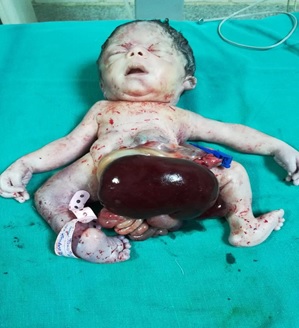The ambit of congenital malformations in the Kachchh district- a hospital-based study at a tertiary care center
Abstract
Background and Aim: Quantifying birth defects in a population is felt as a need as it helps inappropriate allocation of the health budget to tackle and reduce perinatal, neonatal, and infant mortality rates. Hence a study on congenital anomalies was undertaken in the region of Kachchh district.
Material and Methods: Present cross-sectional study was performed on 10 patients diagnosed with having congenital malformed fetuses at tertiary care center- G.K. General Hospital, Bhuj, Kachchh district, Gujarat, India over three months – January, February, March 2019.
Results: Mean age of the study participants were 22.3 years, most (70%) of the study participants were primigravida. Hydrocephalus was the most common birth defect among study participants. Eighty percentages (80%) of study participants had gross anomalies. Sixty percentages (60%) of participants had the outcome of termination.
Conclusion: Congenital anomalies were in babies to mothers between 20-30 years of age. Once an anomaly is detected, various management options are to be discussed with the patients in consultation with a neonatologist, pediatric surgeon, and neurosurgeon when necessary.
Downloads
References
Patel ZM, Adhia RA. Birth defects surveillance. Indian J Pediatrics 2005;72(6):489-491. doi: 10.1007/BF02724426.
Taksande A, Vilhekar K, Chaturvedi P, Jain M. Congenital malformations at birth in Central India: A rural medical college hospital-based data. Indian J Human Genet. 2010;16(3):159-163. doi: 10.4103/0971-6866.73412.
Bhat BV, Ravikumar M. Perinatal mortality in india-need for introspection. Indian J Maternal Childhealth.1996;7:31-33.
CDC. Key findings: Updated National birth prevalence estimates for selected birth defects in the United States, 2004-2006. Available at https://www.cdc.gov/ncbddd/birthdefects/features/birthdefects-keyfindings.html.
Sharma R. Birth defects in India: Hidden truth, need for urgent attention. Indian J Hum Genet. 2013:19(2):125-129. doi: 10.4103/0971-6866.116101.
Sadler T, Langman J. Birth defects and prenatal diagnosis. In: Leland J, editor. Langman's Medical Embryology. 12th ed. Philadelphia: Wolters Kluwer Health/Lippincott Williams and Wilkins; 2012:117-129.
Singh A, Gupta RK. Pattern of Congenital Anomalies in Newborn: A Hospital Based Prospective Study. JK Science. 2009;11(1):11-15.
Swain S, Agarwal S, Bhatia bd. Congenital malformations at birth. Indian Pediatric 1994;31(10):1187-1191.
Kulshrestha R, Nath M, Upadhyaya P. Congenital malformations in live born infants in a rural community. Indian Pediatr. 1983;20(1):45-49.
Chaturvedi P, Banerjee KS. Spectrum of congenital malformations in the newborns from rural Maharashtra. Indian J Pediat. 1989;56(4):501-507. doi: 10.1007/BF02722424.
Grover N. Congenital malformations in Shimla. The Indian J Pediat. 2000;67(4):249-251. doi: 10.1007/BF02758158.
Pandya M, Thakkar J. Study of gross congenital malformations in newborn. J Evol Med Dent Sci 2013;2:4988-4993.
Kulkarni MI. Prenatal diagnosis of genetic disorders. Indian Pediat 1995,32(11):1229-38.
Kalaiselvan G. a study on incidence of congenital anomalies in rural population of cuddaloree district in Tamil Nadu. Rural Med. 2012;40-43.

Copyright (c) 2021 Author (s). Published by Siddharth Health Research and Social Welfare Society

This work is licensed under a Creative Commons Attribution 4.0 International License.


 OAI - Open Archives Initiative
OAI - Open Archives Initiative



















 Therapoid
Therapoid

